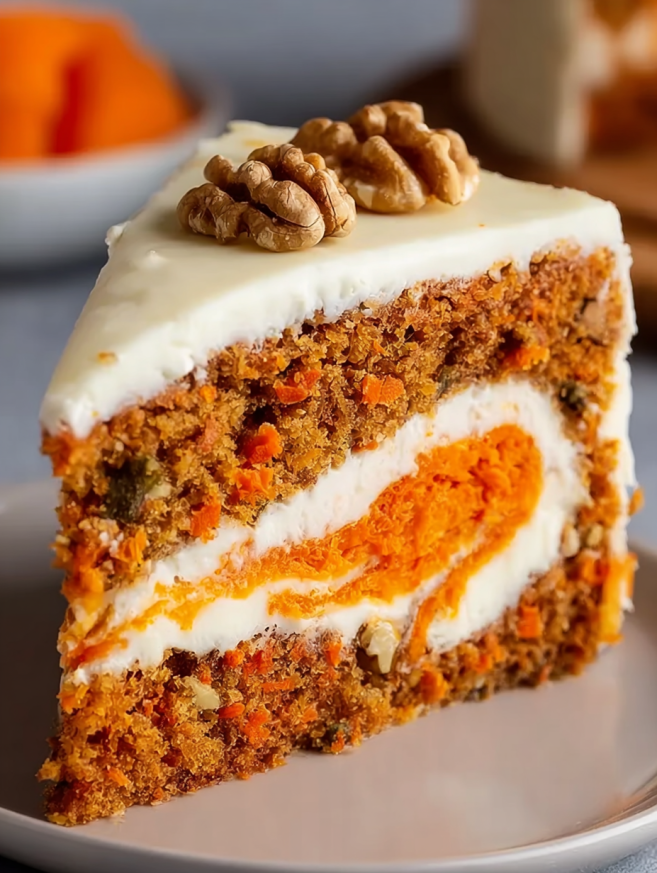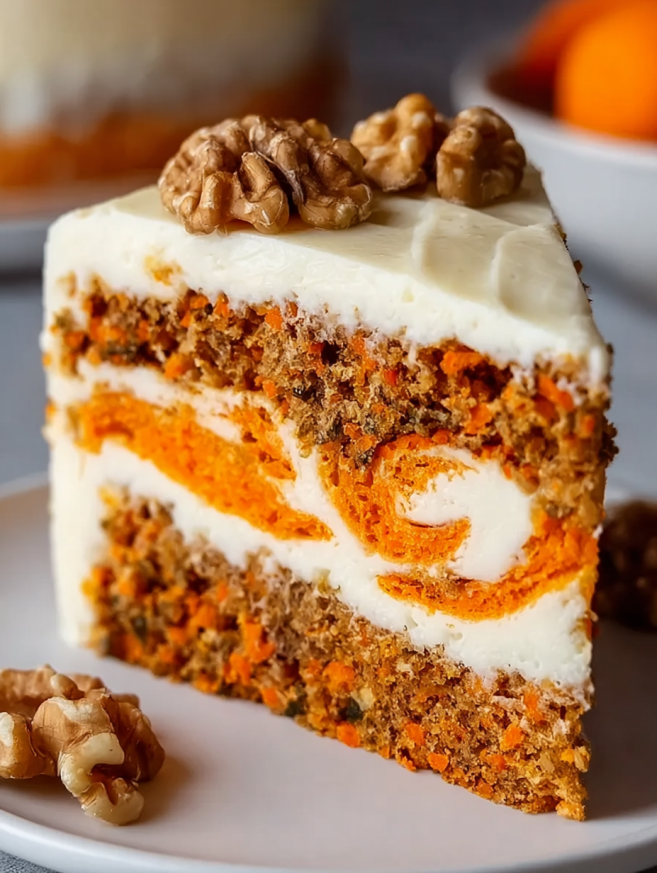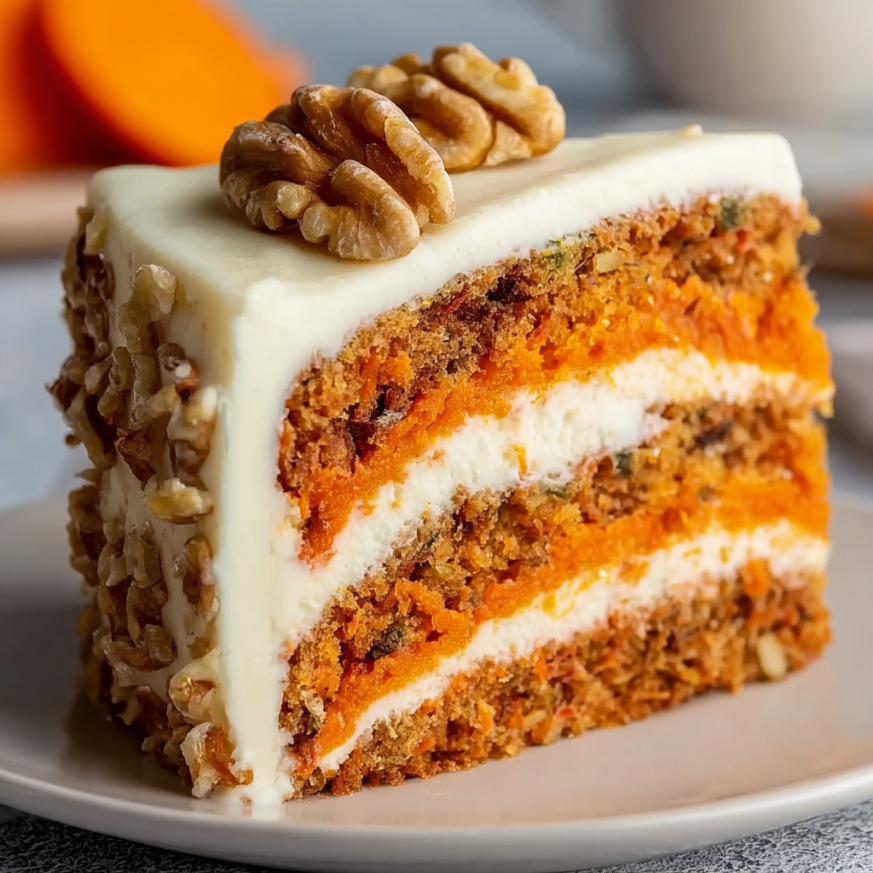There’s nothing quite like the aroma of carrot cake cheesecake baking in the oven—it fills your kitchen with warmth and anticipation. This Carrot Cake Cheesecake is the perfect way to treat yourself or your loved ones to something truly special. Rich, spiced, and irresistibly creamy, it’s sure to become a beloved favorite in your home.
Why You’ll Love This Recipe
The ingredients and steps might seem a bit lengthy at first glance, but trust me, making this dessert is easier than it appears. Even if it takes a little time, every minute is worth it—after all, we’re talking about carrot cake cheesecake! The most challenging part? Waiting for it to cool and chill in the fridge. However, once you finally sink your fork into a slice of this heavenly creation, with its irresistible layers, each bite delivers pure bliss.
Customizable to Your Taste
You can easily customize this recipe to suit your preferences, especially when it comes to nuts. For those with allergies or anyone who simply isn’t a fan of nuts, feel free to leave them out entirely. Instead, consider using crushed graham crackers or Biscoff cookies to maintain that delightful crunch without the nuts!
Love cakes? Be sure to check out these other delicious cake recipes:
- Lemon Blueberry Cake
- Blueberry Cream Cheese Coffee Cake
- Marble Loaf Cake
- Strawberry Crumble Cake
What Makes This Carrot Cake Cheesecake Stand Out
Perfectly Moist and Spiced Carrot Cake
The carrot cake layers are wonderfully moist and spiced with cinnamon and nutmeg, providing a warm, comforting flavor that wraps around you like a cozy blanket. Additionally, the finely grated carrots add natural sweetness and incredible moisture to every bite.
Luxuriously Creamy Cheesecake Filling
Meanwhile, the cheesecake filling is smooth, rich, and incredibly creamy, creating a delightful contrast to the spiced carrot cake. It’s made with high-quality cream cheese for the best possible texture and flavor, ensuring each layer melts in your mouth.
Beautiful Presentation
This dessert isn’t only delicious—it’s also visually stunning. The layers of golden carrot cake and pale cheesecake create a gorgeous cross-section that’s guaranteed to impress your guests. Furthermore, the pecan-topped cream cheese frosting adds the perfect finishing touch.
Recipe Details
Prep Time: 45 minutes
Cook Time: 1 hour
Total Time: 1 hour 45 minutes (plus chilling time)
Course: Dessert
Cuisine: American
Servings: 10
Ingredients
For the Cheesecake Mixture
- 2 packages (8 oz each) cream cheese, softened (but not melted)
- 2/3 cup granulated sugar
- 1 1/2 teaspoons all-purpose flour
- 2 large eggs
- 1 teaspoon vanilla extract
- 1/2 cup sour cream
For the Carrot Cake
- 1 1/4 cups all-purpose flour
- 1/2 teaspoon baking soda
- 1/2 teaspoon baking powder
- 1/4 teaspoon salt
- 1 teaspoon ground cinnamon
- 1/8 teaspoon ground nutmeg
- 1/2 cup canola oil
- 1/4 cup unsweetened applesauce
- 2/3 cup granulated sugar
- 1/3 cup packed light-brown sugar
- 2 large eggs
- 1 teaspoon vanilla extract
- 1 1/3 cups finely grated carrots
For the Topping
- 2 oz cream cheese, softened
- 1 tablespoon butter, softened
- 1 1/4 cups powdered sugar
- 1/4 cup plus 2 tablespoons sour cream
- 1/2 teaspoon vanilla extract
- 1/2 cup chopped pecans (optional)
Ingredient Notes
Cheesecake Mixture Components
Cream cheese serves as the base of the cheesecake, providing that rich and creamy texture we all love. Make sure it’s softened to room temperature for smooth mixing. Granulated sugar sweetens the cheesecake mixture while balancing the tanginess of the cream cheese. Sour cream adds a subtle tang and extra creaminess, contributing to the velvety smooth texture.
Carrot Cake Essentials
Finely grated carrots are the star ingredient that gives the cake its moisture and distinct flavor. Fresh carrots work best for this recipe. Canola oil provides essential moisture and helps keep the carrot cake soft and tender throughout. Ground cinnamon adds warmth and spice, which beautifully complements the natural sweetness of the carrots and sugars.
Topping Ingredients
Cream cheese in the topping adds creaminess that perfectly complements the cheesecake layer below. Powdered sugar sweetens the topping while balancing the tanginess of the cream cheese and sour cream, creating a harmonious flavor profile.
Step-by-Step Instructions
Preparation
Begin by preheating your oven to 350 degrees Fahrenheit. Generously grease a 9-inch springform pan with butter and set it aside for later use.
Making the Cheesecake Mixture
First, whisk together the sugar and 1 1/2 teaspoons of flour in a mixing bowl until well combined. Next, add the cream cheese to the sugar mixture. Using an electric hand mixer set on low speed, blend the cream cheese and sugar mixture until perfectly smooth.
Then, mix in the eggs one at a time, blending just until combined after each addition. Add the vanilla extract with the second egg for even distribution. After that, blend in the sour cream until the mixture is silky smooth.
To remove air bubbles, tap the bowl forcefully against the countertop about 30 times. Set the mixture aside while you prepare the carrot cake batter.
Preparing the Carrot Cake Mixture
Afterward, rinse the beaters clean. In another mixing bowl, whisk together the flour, baking soda, baking powder, salt, cinnamon, and nutmeg for about 30 seconds to ensure even distribution of the spices.
In a separate large mixing bowl, combine the canola oil, applesauce, granulated sugar, brown sugar, eggs, and vanilla extract. Using an electric hand mixer set on low speed, blend the mixture for about 1 minute until well incorporated.
While the mixer runs on low speed, gradually add the dry ingredients to the wet ingredients and mix until everything is well blended. Following this, add the shredded carrots and mix until they’re evenly distributed throughout the batter. Tap the bowl forcefully against the counter about 3 times to release any large air pockets.
Assembling the Cheesecake
Pour 1 1/2 cups of the carrot cake mixture into the buttered springform pan and spread it into an even layer. Spoon about 1/3 of the cream cheese mixture by the spoonfuls over the carrot cake layer—don’t spread or swirl it, as this creates distinct layers.
Next, spoon the remaining carrot cake mixture over the cream cheese layer, distributing it evenly. Then, carefully drizzle the remaining cheesecake mixture over the carrot cake layer, ensuring it covers all of the carrot cake mixture. You can accomplish this by slowly drizzling it over with a spoon, working from the center outward.
Baking
Bake the assembled cake in the preheated oven for 60 to 65 minutes, or until the center portion only jiggles slightly when gently shaken. At the 40-minute mark, tent the cake with aluminum foil to prevent excessive browning. Be careful to ensure the foil doesn’t touch the cheesecake surface, or it will stick.
Cooling and Chilling
Once baked, remove the cake from the oven and allow it to cool on a wire rack for 1 hour. This initial cooling is crucial for the proper texture. Then, cover it with foil and chill it in the refrigerator for at least 6 hours or overnight for the best results.
Adding the Topping
In a mixing bowl, use an electric hand mixer to whip together the cream cheese and butter until smooth and fluffy. Add the remaining topping ingredients and continue mixing until the mixture becomes pale and fluffy, which typically takes about 5 minutes.
Spread the topping evenly over the chilled cheesecake, creating smooth swirls if desired. Then, chill the cheesecake in the freezer for 20 to 30 minutes to set the topping. Finally, sprinkle the chopped pecans around the edges for a beautiful presentation.
Serving
Once chilled, carefully remove the ring from the springform pan and cut the cheesecake into slices using a sharp knife. For the cleanest cuts, wipe the knife between each slice.

Serving Suggestions
Temperature Options
Carrot cake cheesecake can be enjoyed either chilled or at room temperature, depending on your preference. Chilling it makes the cheesecake firmer and allows the flavors to become more pronounced. Conversely, letting it sit at room temperature for 15-20 minutes before serving creates a softer, creamier texture.
Perfect Pairings
Pair this cheesecake with a hot cup of coffee, tea, or cocoa for the ultimate comforting treat. The warmth of the beverage beautifully complements the rich and spiced flavors of the dessert, creating a cozy experience.
Occasion Ideas
This cheesecake is versatile enough to serve as an elegant dessert at formal gatherings or as a special treat for casual get-togethers. It’s perfect for sharing at birthday parties, holiday celebrations, or simply enjoying as an indulgent weekend snack with family.
Recipe Variations
Nut-Free Version
For a nut-free version, simply omit the pecans from the topping. Instead, you can decorate with extra carrot curls, a sprinkle of cinnamon, or even some crushed graham crackers for added texture.
Spice It Up
Feel free to adjust the spices to your liking. Add a pinch of ground ginger or cloves for additional warmth and complexity. Some bakers also enjoy adding a hint of cardamom for an unexpected twist.
Mini Cheesecakes
Transform this recipe into individual servings by using a muffin tin lined with cupcake liners. Adjust the baking time to 25-30 minutes and check for doneness earlier.
Make-Ahead Tips
Advance Preparation
This cheesecake actually benefits from being made ahead of time. You can prepare it up to two days in advance and store it covered in the refrigerator. The flavors meld together beautifully as it sits, making it even more delicious.
Freezing Instructions
For longer storage, this cheesecake freezes beautifully for up to one month. Wrap individual slices tightly in plastic wrap, then aluminum foil, before freezing. Thaw overnight in the refrigerator before serving.
Topping Timing
If making ahead, consider adding the cream cheese topping just a few hours before serving for the freshest appearance. The topping can be prepared and stored separately in the refrigerator for up to three days.
Important Notes
Room Temperature Ingredients
Ensuring your cream cheese, eggs, and butter are at room temperature is crucial for achieving the smoothest, most uniform texture. Cold ingredients won’t blend as seamlessly and can result in a lumpy mixture.
Preventing Cracks
To minimize the risk of cracks in your cheesecake, avoid opening the oven door during baking. Sudden temperature changes can cause the surface to crack. Additionally, the gentle cooling process helps prevent this common issue.
Springform Pan Preparation
For easy removal, consider lining the bottom of your springform pan with parchment paper in addition to greasing it. This extra step ensures the cheesecake releases cleanly when you’re ready to serve.

Frequently Asked Questions
Q: Can I use pre-shredded carrots from the store?
A: While you technically can, freshly grated carrots are highly recommended for the best results. Pre-shredded carrots tend to be drier and may contain preservatives that affect the texture and moisture of your cake. Freshly grated carrots release more moisture and flavor, resulting in a more tender and delicious final product.
Q: Why does my cheesecake need to chill for so long?
A: The extended chilling time is essential for the cheesecake to properly set and develop its full flavor profile. During this time, the layers firm up, making the cheesecake much easier to slice cleanly. Additionally, the flavors have time to meld together, creating a more harmonious and delicious dessert. Patience truly pays off with this recipe!
Q: Can I make this without a springform pan?
A: While a springform pan is ideal for easy removal and beautiful presentation, you can use a regular 9-inch cake pan. However, keep in mind that you’ll need to serve it directly from the pan, as it won’t be possible to remove it in one piece. Line the pan with parchment paper extending over the edges to help with serving.
Q: How do I know when the cheesecake is done baking?
A: The cheesecake is ready when the edges are set but the center still has a slight jiggle—about the size of a quarter—when you gently shake the pan. It will continue to set as it cools. Overbaking can lead to a dry, cracked cheesecake, so it’s better to err on the side of slight underbaking.
Q: Can I substitute the canola oil with something else?
A: Absolutely! You can use vegetable oil, melted coconut oil, or even melted butter as alternatives to canola oil. Each will provide slightly different flavors, with coconut oil adding a subtle tropical note and butter creating a richer taste. Choose based on your preference and what you have available.
Q: How should I store leftover cheesecake?
A: Store any leftover cheesecake in an airtight container in the refrigerator for up to 5 days. The flavors actually improve over the first few days as they continue to develop. For the best texture, let slices sit at room temperature for about 10-15 minutes before serving to take the chill off.
Q: My cheesecake cracked—did I do something wrong?
A: Cracks happen to the best of us and don’t affect the taste at all! They typically occur from overbaking, sudden temperature changes, or overmixing the batter. The good news is that the cream cheese topping completely covers any imperfections, so your dessert will still look and taste amazing.
Store the cheesecake in the refrigerator in an airtight container for optimal freshness and enjoy within 5 days for the best quality.

